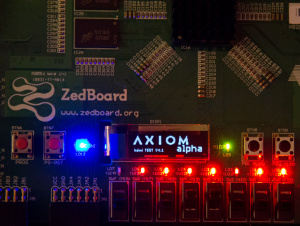Difference between revisions of "HDMI-Test"
From apertus wiki
| Line 1: | Line 1: | ||
[[File:Hmdi-lcd.jpg|thumb|HDMI Test pattern generated by the FPGA displayed on an external LCD TV]] | |||
[[File:Hdmi-zedboard.jpg|thumb|Zedboard Switches with OLED Display]] | |||
# Format an SD card with one vfat partition (this is the default for the SD card that comes with the Zedboard) | # Format an SD card with one vfat partition (this is the default for the SD card that comes with the Zedboard) | ||
# Download http://vserver.13thfloor.at/Stuff/AXIOM/ALPHA/axiom_alpha_hdmi_test_v0.1.zip and put the files in the zipped folder onto your SD card | # Download http://vserver.13thfloor.at/Stuff/AXIOM/ALPHA/axiom_alpha_hdmi_test_v0.1.zip and put all the files in the zipped folder onto your SD card (not into a subfolder) | ||
# Connect a monitor to the Zedboards HDMI port and turn on the monitor. | # Connect a monitor to the Zedboards HDMI port and turn on the monitor. | ||
# Shift all switches on the Zedboard down | # Shift all switches on the Zedboard down | ||
| Line 7: | Line 11: | ||
==Notes== | ==Notes== | ||
If the Zedboard is booting via TFTP by default interrupt the bootloader | If the Zedboard is booting via TFTP by default use an UART / serial console and interrupt the bootloader then type: | ||
env default -f | env default -f | ||
saveenv | saveenv | ||
And reboot the Zedboard with the right pink pushbutton. | And reboot the Zedboard with the right pink pushbutton. | ||
[[Category:Project]] | [[Category:Project]] | ||
[[Category:Zedboard]] | [[Category:Zedboard]] | ||
Revision as of 17:16, 4 October 2013
- Format an SD card with one vfat partition (this is the default for the SD card that comes with the Zedboard)
- Download http://vserver.13thfloor.at/Stuff/AXIOM/ALPHA/axiom_alpha_hdmi_test_v0.1.zip and put all the files in the zipped folder onto your SD card (not into a subfolder)
- Connect a monitor to the Zedboards HDMI port and turn on the monitor.
- Shift all switches on the Zedboard down
- Boot the Zedboard
- After booting is complete turn switch SW3 (fifth from the left) up
Notes
If the Zedboard is booting via TFTP by default use an UART / serial console and interrupt the bootloader then type:
env default -f saveenv
And reboot the Zedboard with the right pink pushbutton.

